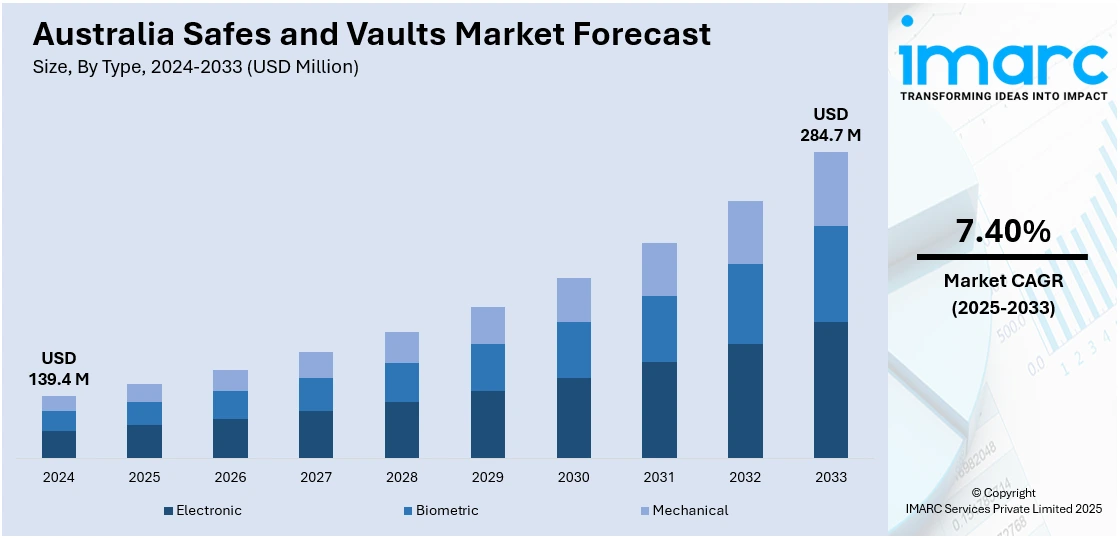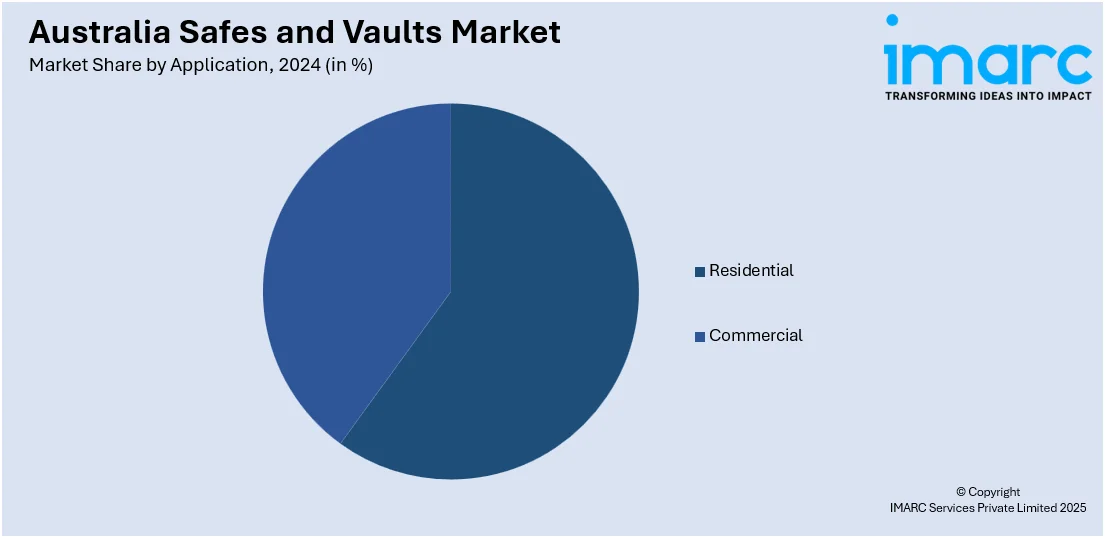
Australia Safes and Vaults Market Size, Share, Trends and Forecast by Type, Function Type, Application, End User, and Region, 2025-2033
Australia Safes and Vaults Market Overview:
The Australia safes and vaults market size reached USD 139.4 Million in 2024. Looking forward, IMARC Group expects the market to reach USD 284.7 Million by 2033, exhibiting a growth rate (CAGR) of 7.40% during 2025-2033. Increasing demand for secure storage, a surge in luxury goods and high-net-worth individuals, stringent regulations for asset protection, rising use of fire-resistant and anti-theft safes, advancements in smart technology integration, growing awareness of cybersecurity, product adoption by financial institutions, and innovations in vault design are factors propelling the market growth.
|
Report Attribute
|
Key Statistics
|
|---|---|
|
Base Year
|
2024 |
|
Forecast Years
|
2025-2033
|
|
Historical Years
|
2019-2024
|
| Market Size in 2024 | USD 139.4 Million |
| Market Forecast in 2033 | USD 284.7 Million |
| Market Growth Rate 2025-2033 | 7.40% |
Australia Safes and Vaults Market Trends:
Increasing Demand for Secure Storage Solutions
One of the prominent factors that is boosting the Australia safes and vaults market share is the growing apprehension about theft, burglary, and protecting costly valuables. Another factor is the increasing security concerns among individuals and enterprises, leading to higher demand for safes and vaults in various regions. Additionally, the rising worth of personal and corporate assets and growing knowledge towards protecting the assets such as cash or valuables, papers and personal data are propelling the market growth. In line with this, the wealthy consumers are investing in state-of-the-art safes and vaults with advanced security, which is fostering the market growth. In residential markets, this trend is exacerbated by a heightened feeling of exposure to home invasions. In the commercial sector, businesses dealing with sensitive data, financial assets, and critical documents are also opting for secure storage solutions to ensure compliance with industry regulations and to mitigate the risk of theft or unauthorized access.

To get more information on this market, Request Sample
Surge in Luxury Goods and High-Net-Worth Individuals
Australia’s increasing population of high-net-worth individuals (HNWIs) has contributed significantly to the demand for safes and vaults. In 2024, the HNWIs in Australia were numbered approximately 690,000 in 2024, marking an 8.7% increase from the previous year. As wealth accumulates, so does the need for more secure storage for luxury items such as art, collectibles, jewelry, and rare assets. HNWIs are often targeted by criminals due to the high value of their possessions, which makes securing these assets a top priority. This demographic’s inclination towards safeguarding their high-value items drives the adoption of advanced safes and vaults with superior features, including fire resistance, biometric access, and sophisticated locking mechanisms. Moreover, the demand for luxury goods, especially with the rise of online marketplaces, has further fueled the need for more secure storage options to protect these valuable assets from theft, which is propelling the Australia safes and vaults market growth.
Stringent Regulations for Asset Protection
Stringent regulations surrounding the protection of financial assets, personal data, and business information is one of the key factors creating a positive Australia safe and vaults market outlook. Regulatory compliance with industry standards such as the Privacy Act 1988 and the Australian Securities and Investments Commission’s (ASIC) regulations for financial institutions has established a demand for secure storage for businesses across the country. Additionally, financial organizations, law firms, health care providers, and the government are increasingly securing sensitive information and possessions against theft, unauthorized intrusion, and disasters, which is fostering the market growth. These regulatory requirements help secure businesses to update their security infrastructure per changing laws and safeguard clients' valuable data and assets which also increases the demand of safes and vaults market.
Australia Safes and Vaults Market Segmentation:
IMARC Group provides an analysis of the key trends in each segment of the market, along with forecasts at the country and regional levels for 2025-2033. Our report has categorized the market based on type, function type, application, and end user.
Type Insights:
- Electronic
- Biometric
- Mechanical
The report has provided a detailed breakup and analysis of the market based on the type. This includes electronic, biometric, and mechanical.
Function Type Insights:
- Cash Management Safes
- Depository Safes
- Gun Safes and Vaults
- Vaults and Vault Doors
- Media Safes
- Others
A detailed breakup and analysis of the market based on the function type have also been provided in the report. This includes cash management safes, depository safes, gun safes and vaults, vaults and vault doors, media safes, and others.
Application Insights:

- Residential
- Commercial
The report has provided a detailed breakup and analysis of the market based on the application. This includes residential and commercial.
End User Insights:
- Banking Sector
- Non-Banking Sector
A detailed breakup and analysis of the market based on the end user have also been provided in the report. This includes banking sector and non-banking sector.
Regional Insights:
- Australia Capital Territory & New South Wales
- Victoria & Tasmania
- Queensland
- Northern Territory & Southern Australia
- Western Australia
The report has also provided a comprehensive analysis of all the major regional markets, which include Australia Capital Territory & New South Wales, Victoria & Tasmania, Queensland, Northern Territory & Southern Australia, and Western Australia.
Competitive Landscape:
The market research report has also provided a comprehensive analysis of the competitive landscape. Competitive analysis such as market structure, key player positioning, top winning strategies, competitive dashboard, and company evaluation quadrant has been covered in the report. Also, detailed profiles of all major companies have been provided.
Australia Safes and Vaults Market News:
- In 2024, George Hulbert Seed Vault in Wagga Wagga, Australia, was inaugurated as a high-security facility for preserving global rice heritage. This state-of-the-art vault showcases advanced storage technology, underscoring the growing demand for specialized, secure vault solutions in safeguarding valuable agricultural assets and genetic materials.
Australia Safes and Vaults Market Report Coverage:
| Report Features | Details |
|---|---|
| Base Year of the Analysis | 2024 |
| Historical Period | 2019-2024 |
| Forecast Period | 2025-2033 |
| Units | Million USD |
| Scope of the Report | Exploration of Historical Trends and Market Outlook, Industry Catalysts and Challenges, Segment-Wise Historical and Future Market Assessment:
|
| Types Covered | Electronic, Biometric, Mechanical |
| Function Types Covered | Cash Management Safes, Depository Safes, Gun Safes and Vaults, Vaults and Vault Doors, Media Safes, Others |
| Applications Covered | Residential, Commercial |
| End Users Covered | Banking Sector, Non-Banking Sector |
| Regions Covered | Australia Capital Territory & New South Wales, Victoria & Tasmania, Queensland, Northern Territory & Southern Australia, Western Australia |
| Customization Scope | 10% Free Customization |
| Post-Sale Analyst Support | 10-12 Weeks |
| Delivery Format | PDF and Excel through Email (We can also provide the editable version of the report in PPT/Word format on special request) |
Key Questions Answered in This Report:
- How has the Australia safes and vaults market performed so far and how will it perform in the coming years?
- What is the breakup of the Australia safes and vaults market on the basis of type?
- What is the breakup of the Australia safes and vaults market on the basis of function type?
- What is the breakup of the Australia safes and vaults market on the basis of application?
- What is the breakup of the Australia safes and vaults market on the basis of end user?
- What is the breakup of the Australia safes and vaults market on the basis of region?
- What are the various stages in the value chain of the Australia safes and vaults market?
- What are the key driving factors and challenges in the Australia safes and vaults market?
- What is the structure of the Australia safes and vaults market and who are the key players?
- What is the degree of competition in the Australia safes and vaults market?
Key Benefits for Stakeholders:
- IMARC’s industry report offers a comprehensive quantitative analysis of various market segments, historical and current market trends, market forecasts, and dynamics of the Australia safes and vaults market from 2019-2033.
- The research report provides the latest information on the market drivers, challenges, and opportunities in the Australia safes and vaults market.
- Porter's five forces analysis assist stakeholders in assessing the impact of new entrants, competitive rivalry, supplier power, buyer power, and the threat of substitution. It helps stakeholders to analyze the level of competition within the Australia safes and vaults industry and its attractiveness.
- Competitive landscape allows stakeholders to understand their competitive environment and provides an insight into the current positions of key players in the market.
Need more help?
- Speak to our experienced analysts for insights on the current market scenarios.
- Include additional segments and countries to customize the report as per your requirement.
- Gain an unparalleled competitive advantage in your domain by understanding how to utilize the report and positively impacting your operations and revenue.
- For further assistance, please connect with our analysts.
 Request Customization
Request Customization
 Speak to an Analyst
Speak to an Analyst
 Request Brochure
Request Brochure
 Inquire Before Buying
Inquire Before Buying




.webp)




.webp)












